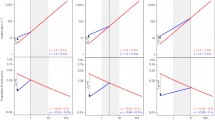Abstract
replying to H. C. Giacomini, B. Shuter, D. T. de Kerckhove & P. A. Abrams Nature 493, 10.1038/nature11829 (2012)
Current studies assume that per-capita consumption rates always scale with body mass to an exponent of 0.75. We showed that, contrary to this assumption, consumption rates scale sublinearly (exponent of approximately 0.85) when organisms forage in two dimensions (2D), and superlinearly (exponent of approximately 1.06) when they forage in 3D1. Giacomini et al. argue that the superlinear scaling in 3D interactions we observed cannot be reconciled with life-history theory for maximal body size2. Consequently, they search for biases in our study that might cause this superlinear scaling. However, their comments do not challenge our central result that consumption rates scale superlinearly in 3D, and significantly more steeply than in 2D. We propose instead that life-history theory may need revision to include interaction dimensionality.

Similar content being viewed by others
References
Pawar, S., Dell, A. I. & Savage, V. M. Dimensionality of consumer search space drives trophic interaction strengths. Nature 486, 485–489 (2012)
Giacomini, H. C., Shuter, B., de Kerckhove D. T & Abrams, P. A. Does consumption rate scale superlinearly? Nature 493, http://dx.doi.org/10.1038/nature11829 (2012)
Savage, V. M. et al. Comment on ‘The illusion of invariant quantities in life histories’. Science 312, 198 (2006)
Peters, R. H. The Ecological Implications of Body Size (Cambridge Univ. Press, 1983)
Nagy, K. A. Field metabolic rate and food requirement scaling in mammals and birds. Ecol. Monogr. 57, 111–128 (1987)
Harrison, J. F., Kaiser, A. & VandenBrooks, J. M. Atmospheric oxygen level and the evolution of insect body size. Proc. R. Soc. Lond. B 277, 1937–1946 (2010)
Charnov, E. L. Evolution of mammal life histories. Evol. Ecol. Res. 3, 521–535 (2001)
Charnov, E. L. & Gillooly, J. F. Size and temperature in the evolution of fish life histories. Integr. Comp. Biol. 44, 494–497 (2004)
Quince, C., Abrams, P., a, Shuter, B. J. & Lester, N. P. Biphasic growth in fish I: theoretical foundations. J. Theor. Biol. 254, 197–206 (2008)
Hartvig, M., Andersen, K. H. & Beyer, J. E. Food web framework for size-structured populations. J. Theor. Biol. 272, 113–122 (2011)
Author information
Authors and Affiliations
Corresponding author
PowerPoint slides
Rights and permissions
About this article
Cite this article
Pawar, S., Dell, A. & Van M. Savage Pawar et al. reply. Nature 493, E2–E3 (2013). https://doi.org/10.1038/nature11830
Published:
Issue Date:
DOI: https://doi.org/10.1038/nature11830
- Springer Nature Limited
This article is cited by
-
Foraging constraints reverse the scaling of activity time in carnivores
Nature Ecology & Evolution (2017)





